Bitcoin
Is Bitcoin Doomed Without an Urgent Green Blockchain Upgrade?

The debate over cryptocurrencies’ environmental impact has intensified as governments, corporations, and investors focus on Environmental, Social, and Governance (ESG) concerns. Bitcoin, the world’s most prominent cryptocurrency, is leading the criticism, known for its energy-intensive Proof-of-Work (PoW) consensus mechanism.
While innovations are emerging across the crypto industry to address environmental concerns, Bitcoin’s contribution to global carbon emissions remains a major point of contention.
Bitcoin’s Environmental Problem
Bitcoin’s PoW mechanism relies on miners solving complex cryptographic problems, consuming vast amounts of computational power and energy.
According to estimates from the University of Cambridge, Bitcoin’s annual energy consumption rivals that of entire nations such as Argentina or Norway. Moreover, Bitcoin’s environmental footprint is exacerbated in regions where mining operations are powered by non-renewable energy sources.
“Bitcoin mining may be responsible for 65.4 megatonnes of CO2 (MtCO2) per year, which is comparable to country-level emissions in Greece (56.6 MtCO2 in 2019) and represents 0.19% of global emissions,” a report titled Revisiting Bitcoin’s Carbon Footprint read.
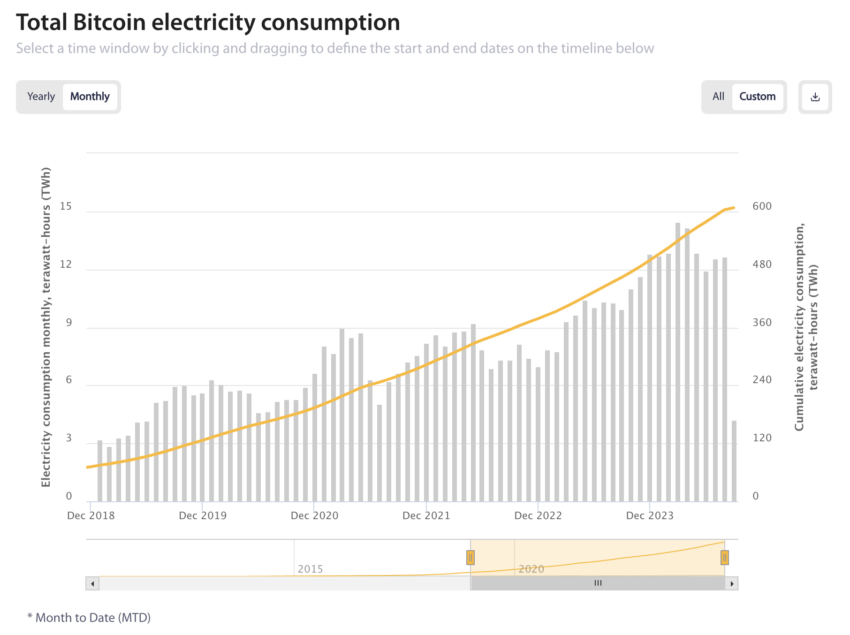
Critics argue that this consumption is disproportionate and unsustainable, especially in light of global climate commitments. While alternative cryptocurrencies are exploring eco-friendly mechanisms, Bitcoin’s slow adaptation to such technologies has raised concerns.
“Everybody recognizes Bitcoin is environmentally unhealthy, but any big changes to Bitcoin protocol have been very unsuccessful because you need to get all the miners to agree on that,” Hanna Halaburda, Associate Professor of Information at NYU Stern School of Business, said.
If environmental sustainability becomes a core expectation of investors and regulators, Bitcoin may soon face increasing pressure to upgrade.
A Green Shift in Crypto
In contrast to Bitcoin, other blockchain platforms have already taken steps to reduce their environmental impact. Ethereum, for instance, made headlines in 2022 with its shift from PoW to Proof-of-Stake (PoS), cutting its energy consumption by over 99%. PoS replaces energy-hungry mining with validators who lock up tokens as collateral to secure the network.
This transformation set a precedent for the industry, showing that eco-friendly upgrades are possible even in established networks.
Read more: Proof of Work and Proof of Stake Explained
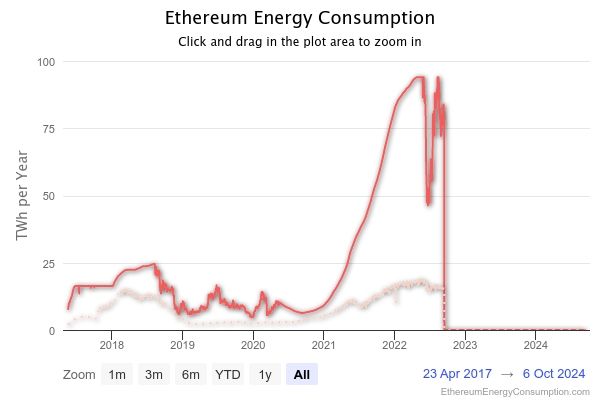
Other platforms like Hedera, Cardano, and Tezos also boast PoS mechanisms and are increasingly focusing on sustainability. Hedera’s involvement in carbon offsetting projects and its collaboration with the Global Blockchain Business Council (GBBC) to promote environmental standards are further steps toward reducing blockchain’s ecological footprint.
In an exclusive interview with BeInCrypto, Wes Geisenberger, Vice President of Sustainability and ESG at HBAR, noted the importance of the GBBC InterWork Alliance’s Carbon Emission Token (CET) Task Force. This task force, developed to address carbon accounting at a technical level, is helping companies navigate these regulations.
“The CET is a positive contribution, very much driven by the changes coming from governments and corporates looking for solutions to credibly address their environmental impact,” Geisenberger said.
This kind of technical development highlights the growing intersection of blockchain and environmental governance. The crypto industry is increasingly collaborating with government bodies and international organizations to find solutions that meet regulatory expectations while leveraging blockchain’s potential to innovate.
Investors are Paying Attention
Investor sentiment is increasingly aligned with global ESG priorities. Climate-conscious investors are urging industries, including crypto, to take accountability for their environmental impact. In response, some blockchain ecosystems are leading climate-focused efforts, both through technological innovation and by funding sustainable projects.
According to Geisenberger, the HBAR Foundation’s Sustainable Impact Fund is one of the first grant-based funds aimed at promoting blockchain’s role in sustainability. This fund supports initiatives like the Hedera Guardian, a public ledger platform designed to improve transparency in carbon credit markets.
By enabling institutions and startups to track and verify their carbon-offsetting efforts, Hedera has shown how blockchains can facilitate responsible environmental practices.
“The Hedera Guardian has already onboarded 500 million metric tonnes of carbon credits. We see these tools helping answer challenges to enable outcomes to measure our planet’s externalities and give agency to folks participating in environmental and biodiversity projects to better trace flows of funds back to the community,” Geisenberger explained.
Despite these positive developments in the broader blockchain ecosystem, Bitcoin’s reliance on PoW remains unchanged. Bitcoin advocates argue that its decentralized nature and security features are unparalleled and that any shift in its consensus mechanism could jeopardize its integrity. They point to Bitcoin miners’ adoption of renewable energy as a possible solution to its environmental challenges.
Some mining operations are indeed migrating to regions with abundant hydroelectric, wind, and solar power. However, these efforts are still piecemeal and lack industry-wide coordination.
“A lot of Bitcoin mining companies have set up their contracts with renewable energy companies. The argument is that having these mining facilities as clients means that when there’s an oversupply of energy, it may actually make it more profitable for the renewable energy plants,” Halaburda added.
Read more: 5 Best Platforms To Buy Bitcoin Mining Stocks After 2024 Halving
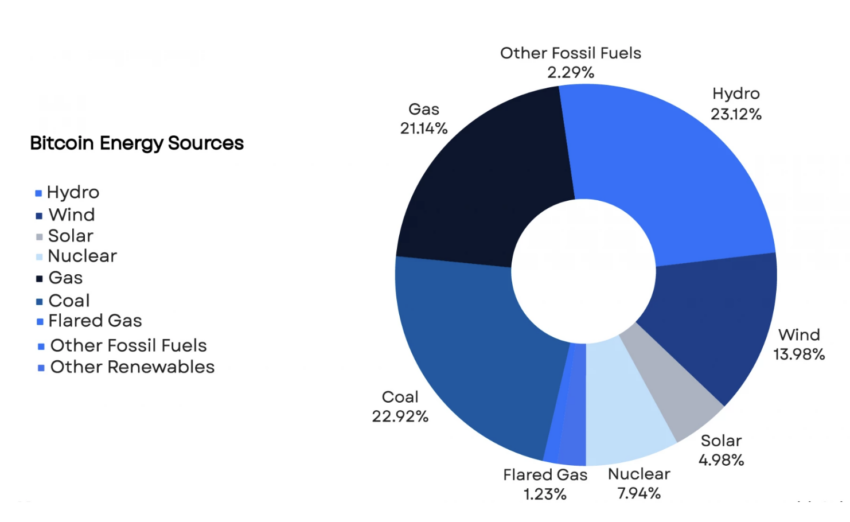
The question, then, is whether Bitcoin will be able to evolve in an increasingly ESG-driven world. The industry’s focus on renewable energy and carbon offsetting projects offers some hope, but it may not be enough if regulatory frameworks impose stricter environmental requirements.
Challenges in Standardizing ESG Metrics
While some crypto platforms have made strides toward sustainability, the challenge of standardizing ESG metrics across the industry persists. Blockchain technology’s decentralized and often opaque nature complicates the task of measuring environmental impact consistently and comparably.
Efforts like the CET protocol are helping to fill this gap, but broader industry-wide adoption is necessary for meaningful change. Without standardization, it remains difficult to gauge which platforms are truly sustainable and which are relying on surface-level commitments.
There is also the challenge of balancing the interests of investors, users, and environmental advocates, each of whom has different expectations regarding the future of blockchain technology.
As regulations tighten and the global push for sustainability accelerates, Bitcoin’s environmental footprint will likely become harder to ignore. The crypto industry has demonstrated that it can innovate and adapt, but Bitcoin, as the original and most influential cryptocurrency, faces an uphill battle. It may ultimately require either an upgrade in its consensus mechanism or a significant investment in renewable energy solutions.
Disclaimer
Following the Trust Project guidelines, this feature article presents opinions and perspectives from industry experts or individuals. BeInCrypto is dedicated to transparent reporting, but the views expressed in this article do not necessarily reflect those of BeInCrypto or its staff. Readers should verify information independently and consult with a professional before making decisions based on this content. Please note that our Terms and Conditions, Privacy Policy, and Disclaimers have been updated.
Bitcoin
US Economic Indicators to Watch & Potential Impact on Bitcoin

Several US economic indicators are in the pipeline this week, with potential implications for Bitcoin and crypto.
US macroeconomic data have broadly influenced sentiment in the cryptocurrency market over the past several months. Therefore, it is imperative that traders and investors adjust their portfolios and align their trading strategies to capitalize on key economic events.
US Economic Events This Week
Several factors, including macroeconomic sentiment, monetary policy expectations, and Bitcoin’s growing narrative as a hedge or risk asset, influence Bitcoin’s price dynamics. These make the following indicators particularly relevant this week.

US Leading Economic Indicators
The first US economic indicator that could influence Bitcoin price is March’s leading economic indicator, due today, Monday, April 21.
The Conference Board Leading Economic Index (LEI), last reported for February 2025, declined by 0.3% month-over-month (MoM) after a revised 0.1% increase in December 2024.
This drop, driven by pessimistic consumer expectations and weaker manufacturing orders, continued a trend of negative signals. However, the six-month growth rate is improving, suggesting less severe headwinds than in 2024.
There is a median forecast of a 0.5% decline for the March report, versus a consensus of -0.6%. While these data points to economic slowdown, stabilizing trends and a projected 2.0% GDP growth for 2025 offer some optimism.
However, policy uncertainties, such as Trump’s tariffs, could exacerbate risks. For Bitcoin, declining LEI may dampen risk appetite, pushing investors toward safer assets like bonds and pressuring prices in the short term.
Conversely, Bitcoin’s “digital gold” narrative could gain traction if economic uncertainty fuels distrust in fiat systems. However, this is less likely unless broader trade tensions or policy shocks amplify the effect.
Services PMI
The S&P Global US Services PMI for March 2025 climbed to 54.4 from 51.0 in February, signaling strong expansion in the services sector. This rise, paired with a composite PMI 53.5, reflects resilient consumer demand.
This strength bolsters the US dollar, reducing expectations for Federal Reserve (Fed) rate cuts, which could challenge Bitcoin’s appeal. A stronger dollar and higher yields typically weigh on Bitcoin, as seen in past cycles when real yields rise.
However, rising input costs and tariff concerns temper business confidence. For the April Services PMI, the median forecast is 53.0.
Strong services activity may support broader risk-on sentiment, potentially lifting Bitcoin if equity markets rally, given its occasional correlation with indices like the Nasdaq.
Still, tariff uncertainties could cap any negative pressure, keeping the impact neutral to slightly bearish, as dollar strength overshadows marginal risk-on gains.
Manufacturing PMI
In contrast, the S&P Global US Manufacturing PMI for March 2025 fell to 50.2 from 52.7, hovering near stagnation. Meanwhile, the ISM Manufacturing PMI contracted to 49.0 from 50.3, with new orders, production, and employment declines.
This weakness, consistent with October 2024’s ISM reading 46.5, reflects high interest rates, weak global demand, and tariff-related uncertainty.
Moody’s Analytics and Statista highlight manufacturing’s struggles, warning of broader slowdown risks, especially with trade policy volatility under the Trump administration.
For Bitcoin, weak manufacturing data signals reduced risk appetite, likely exerting downward pressure, particularly given its equity market correlation.
While a sharp manufacturing decline could theoretically spur rate-cut expectations, persistent inflation and tariff-driven cost pressures make this unlikely. The outlook here is bearish, as fears of economic slowdown dominate.
“S&P Global Services/ManufacturingPMI (Wednesday): The pulse of the economy. Watch for a dip or rise in the numbers…it could hint at whether the recovery is running out of gas or shifting into overdrive,” one user remarked.
Initial Jobless Claims
Initial Jobless Claims for the week ending April 19 recorded 215,000, down from 223,000 the week before.
It indicates a slight improvement but still reflects a labor market under pressure, suggesting ongoing challenges. High interest rates, cautious business investment, and uncertainties surrounding tariff policies likely drive this sentiment by eroding employer confidence.
“…66% of Americans expect higher unemployment in the next 12 months, the highest share since the Great Financial Crisis. Such sharp spikes have never occurred outside of recessions. The job market is set to get worse pretty quickly,” one analyst noted recently.
Nevertheless, despite reduced hiring and economic pressures, the decline suggests some layoff stabilization.
Analysts note that lower claims could ease concerns about rapid deterioration, persistent inflation, and policy uncertainties, which limit expectations for Fed rate cuts.
Meanwhile, jobless claims are a critical driver of Bitcoin sentiment. The modest drop in claims may temper economic weakness signals. If claims continue to decline significantly, sparking hopes of monetary easing, Bitcoin could benefit from increased liquidity and lower yields.
Consumer Sentiment
Consumer Sentiment, as measured by the University of Michigan’s index, was 50.8 in March 2025. This was a modest drop from February’s reading, reflecting tariff-related pessimism and inflation fears despite solid economic conditions.
Preliminary March data suggests a reading of 50.8, with sentiment still sour, per TradingEconomics estimates.
“US consumer sentiment is lower than in the great financial crisis. Consumer sentiment fell to 50.8, the 2nd-lowest level in history. The sentiment is lower than during every US recession over the last 50 years…This is a crisis,” a global markets investor noted.
Consumer sentiment is a gauge of retail investor confidence, critical for Bitcoin’s retail-driven market. Lower sentiment could sap enthusiasm for speculative assets, pushing Bitcoin lower, especially if risk-off sentiment dominates.
Conversely, if sentiment stabilizes or tariff fears ease, Bitcoin could ride a risk-on wave, though this seems unlikely given current trends.
The probable effect is bearish, as declining confidence aligns with broader economic caution.
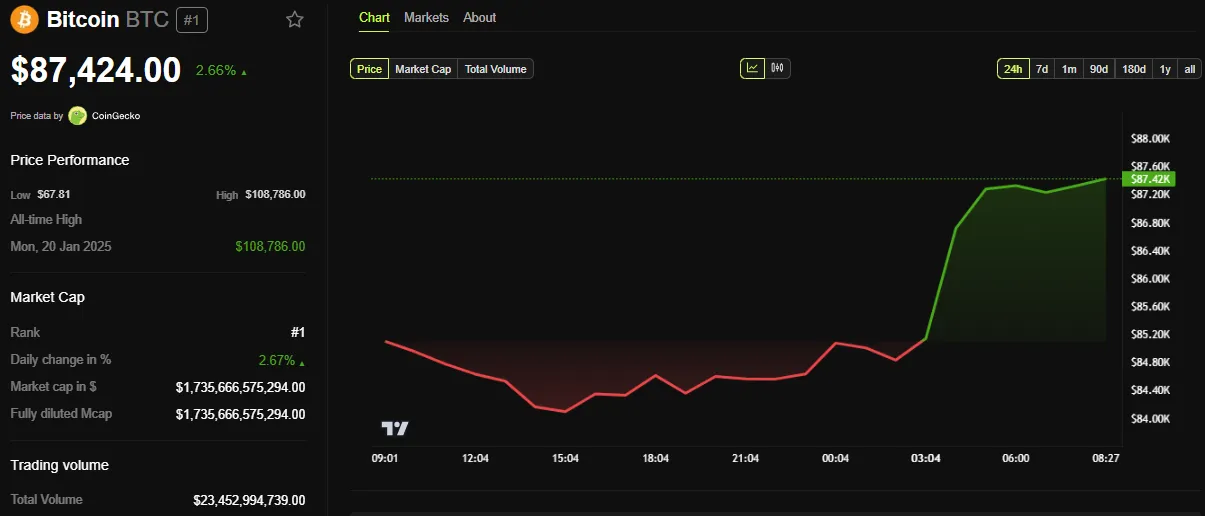
BeInCrypto data shows Bitcoin (BTC) was trading for $87,424 as of this writing. This represents a modest 2.66% gain in the last 24 hours.
Disclaimer
In adherence to the Trust Project guidelines, BeInCrypto is committed to unbiased, transparent reporting. This news article aims to provide accurate, timely information. However, readers are advised to verify facts independently and consult with a professional before making any decisions based on this content. Please note that our Terms and Conditions, Privacy Policy, and Disclaimers have been updated.
Bitcoin
Here Are The Bitcoin Levels To Watch For The Short Term


Bitcoin has produced a range-bound movement recently, with prices oscillating between $83,000 and 86,000. Interestingly, popular crypto analyst Burak Kesmeci has identified the important price levels for any short-term action.
Support At 82,800, Resistance At 92,000 – But Where Is Bitcoin Headed?
In a new post on X, Kesmeci shared an interesting on-chain analysis of the Bitcoin market. Using the short-term investor cost basis, the analyst identified two key price levels that could prove critical to Bitcoin’s next major move.
Firstly, Burak Kesmeci focuses on the average cost prices of new traders over the past 1-4 weeks, which are likely the most reactive to price changes. The realized price for these traders currently stands at $82,800, forming a near-term support that indicates many recent buyers are still in profit and may defend this level as a psychological floor.
Meanwhile, Kesmeci also highlights the $92,000 price level, which marks the average cost basis for BTC holders for 1-3 months. This price point has emerged as an important resistance zone, as investors are likely to exit the market once they break even. Furthermore, the $92,000 price level is also marked by a confluence with various technical indicators.
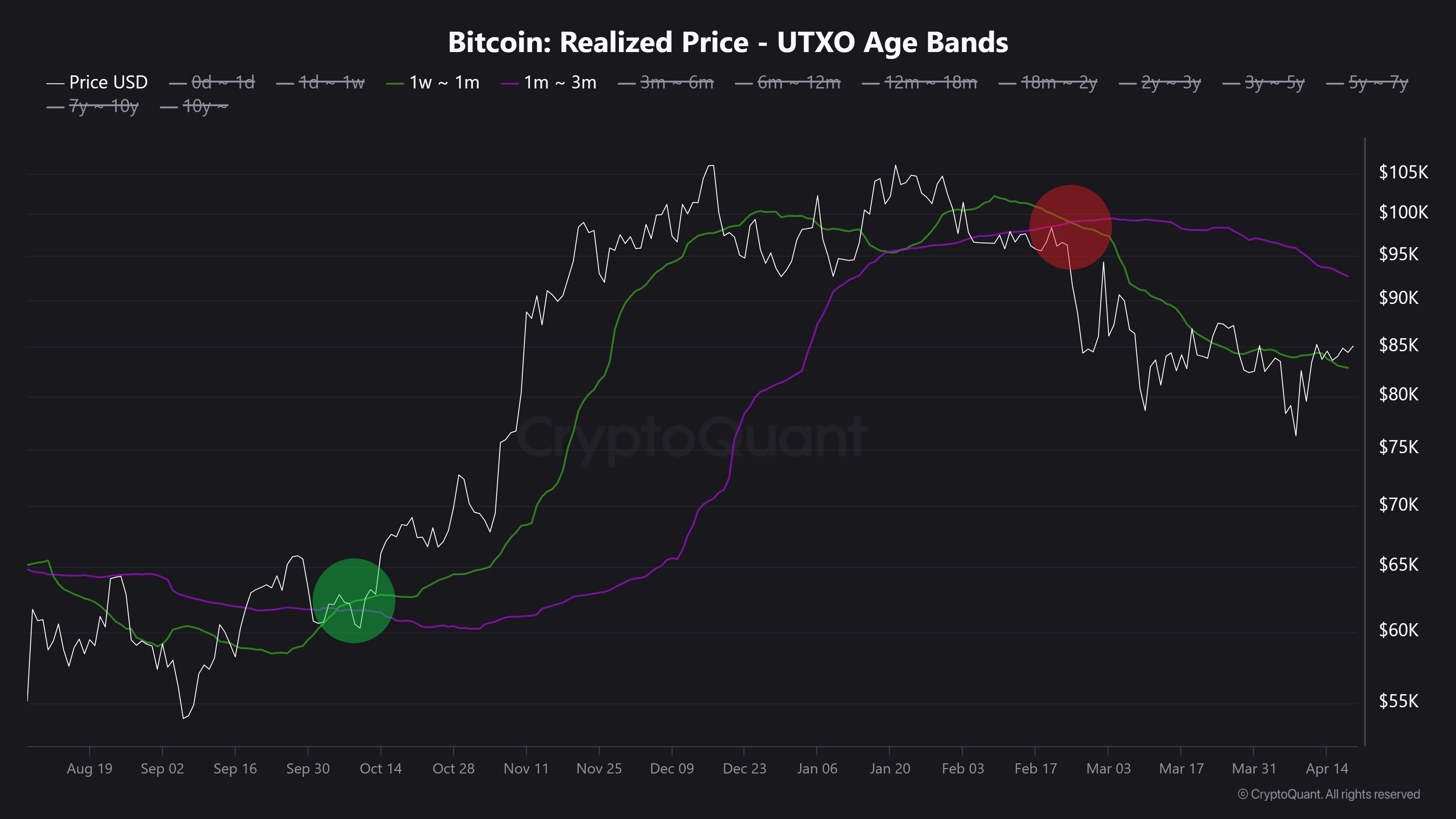
The interplay between these two levels is significant. Historically, short-term bullish trends in BTC tend to begin when the cost basis of more recent investors, 1–4 weeks, crosses above that of the 1–3 BTC holders. This shift signals increased confidence and willingness to buy at higher levels, which often fuels broader rallies.
However, that dynamic remains to play out in the current market. As of now, Bitcoin is trading around 85,000, positioning it above its support at the 1–4 week average of $82,800 but still below the 1–3 month resistance of $92,000. Furthermore, both cost basis levels have been declining over the past two months, reflecting hesitation or a lack of aggressive buying from new entrants.
Notably, Kesmeci states that BTC must surge above $92,000 to confirm a strong bullish momentum for a price reversal.
Bitcoin ETFs Offload 1,725 BTC
In other news, Ali Martinez reports that the Bitcoin ETFs have suffered withdrawals of 1,725 Bitcoin, valued at $146.92 million, over the past week. This development illustrates a high level of negative sentiment among institutional investors, adding to market uncertainty around the BTC market.
Meanwhile, Bitcoin trades at $85,249 following a price change of 0.89% in the past day. The premier cryptocurrency also reflects a 0.58% loss on the weekly chart and a 1.06% gain on a monthly chart.
Feature image from Adobe Stock, chart from Tradingview

Editorial Process for bitcoinist is centered on delivering thoroughly researched, accurate, and unbiased content. We uphold strict sourcing standards, and each page undergoes diligent review by our team of top technology experts and seasoned editors. This process ensures the integrity, relevance, and value of our content for our readers.
Bitcoin
Bitcoin LTH Selling Pressure Hits Yearly Low — Bull Market Ready For Take Off?


Following an extensive price correction in the past three months, the Bitcoin bull market continues to hang in the balance. Despite a modest price rebound in April, the premier cryptocurrency is yet to display a strong intent to resume its bull rally amidst a lack of positive market factors. However, crypto analyst Axel Adler Jr. has highlighted a promising development that could signal major upside potential for Bitcoin.
Bitcoin Long-Term Holders Looking To Halt Selling Pressure
In a recent post on X, Adler Jr. shared an important update in Bitcoin long-term holders (LTH) activity, which could prove significantly positive for the broader BTC market.
Using on-chain data from CryptoQuant, the renowned analyst reports that selling pressure by long-term holders, i.e. amount of LTH holdings on exchanges, has now hit its lowest point at 1.1% over the past year. This development indicates that Bitcoin LTH are now opting to hold on to their assets rather than take profits.
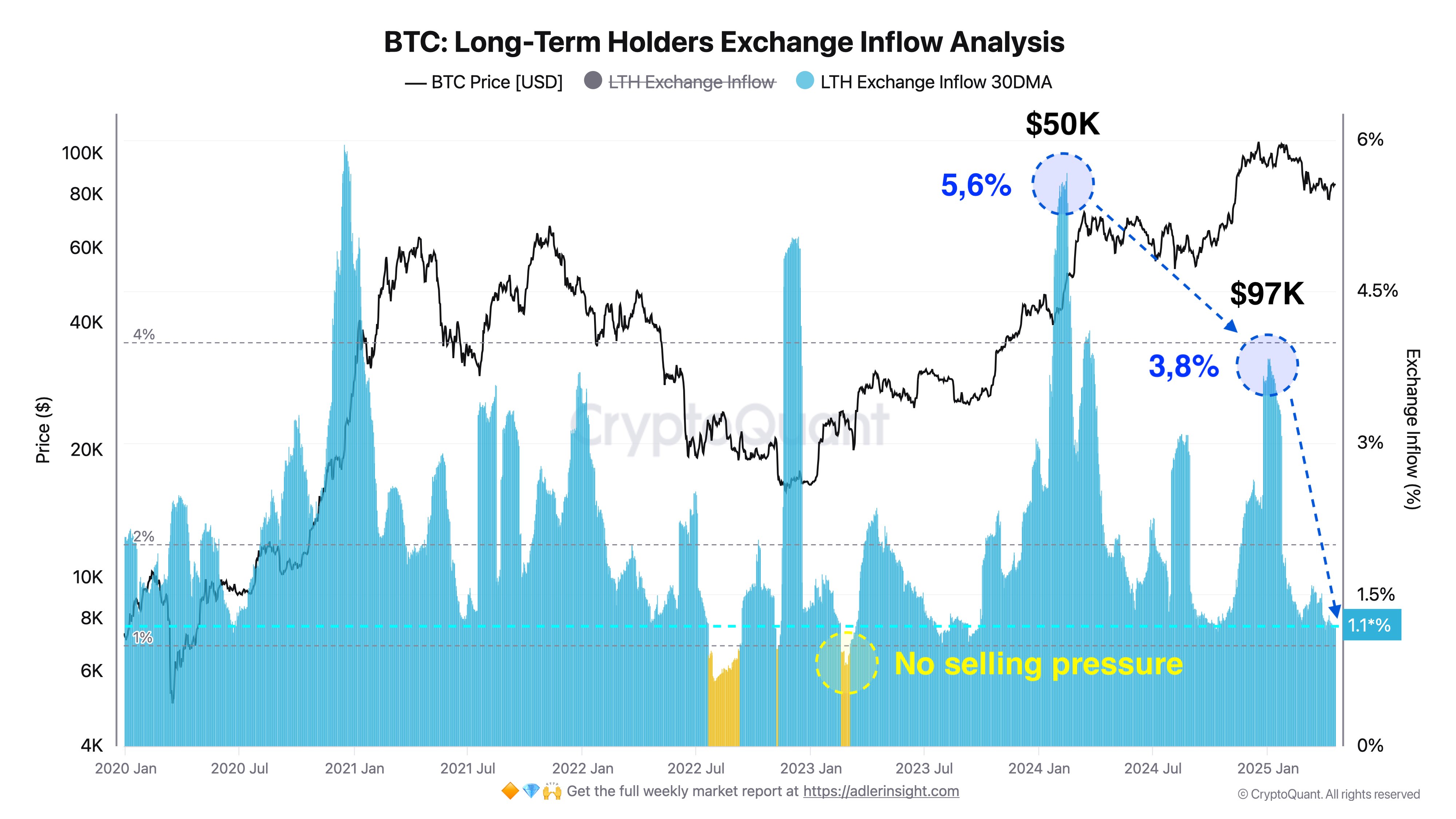
Adler explains that a further decline in these LTH exchange holdings to 1.0% would signal the total absence of selling pressure. Notably, this development could encourage new market entry and sustained accumulation, creating a strong bullish momentum in the BTC market.
Importantly, Alder highlights that the majority of the Bitcoin LTH entered the market at an average price of $25,000, Since then, CryptoQuant has recorded the highest LTH selling pressure of 5.6% at $50,000 in early 2024 and 3.8% at $97,000 in early 2025.
According to Adler, these two instances likely represent the primary profit-taking phases for long-term holders who intended to exit the market. Therefore, a resurgence in selling pressure from this cohort of BTC investors is unlikely in the short-term, which supports a building bullish case as long-term holders currently control 77.5% of Bitcoin in circulation.
BTC Price Overview
At the time of writing, Bitcoin was trading at $85,226 following a 0.36% gain in the past day and a 0.02% loss in the past week. Both metrics only reflect the ongoing market consolidation as BTC continues to struggle to achieve a convincing price breakout beyond $86,000.
Meanwhile, the asset’s performance on the monthly chat now reflects a 1.97% gain, indicating a potential trend reversal as the market correction ceases. Nevertheless, BTC remains in need of a strong market catalyst to ignite any sustainable price rally. With a market cap of $1.67 trillion, Bitcoin is ranked as the largest digital asset, controlling 62.9% of the crypto market.
Featured image from Adobe Stock, chart from Tradingview

Editorial Process for bitcoinist is centered on delivering thoroughly researched, accurate, and unbiased content. We uphold strict sourcing standards, and each page undergoes diligent review by our team of top technology experts and seasoned editors. This process ensures the integrity, relevance, and value of our content for our readers.
-

 Market15 hours ago
Market15 hours ago1 Year After Bitcoin Halving: What’s Different This Time?
-

 Ethereum22 hours ago
Ethereum22 hours agoEthereum Consolidates In Symmetrical Triangle: Expert Predicts 17% Price Move
-

 Market21 hours ago
Market21 hours agoToday’s $1K XRP Bag May Become Tomorrow’s Jackpot, Crypto Founder Says
-

 Market19 hours ago
Market19 hours agoMELANIA Crashes to All-Time Low Amid Insiders Continued Sales
-

 Market20 hours ago
Market20 hours agoCharles Schwab Plans Spot Crypto Trading Rollout in 2026
-

 Market16 hours ago
Market16 hours agoVOXEL Climbs 200% After Suspected Bitget Bot Glitch
-

 Ethereum24 hours ago
Ethereum24 hours agoEthereum Accumulators At A Crucial Moment: ETH Realized Price Tests Make-Or-Break Point
-

 Ethereum21 hours ago
Ethereum21 hours agoEthereum Enters Historic Buy Zone As Price Dips Below Key Level – Insights


















